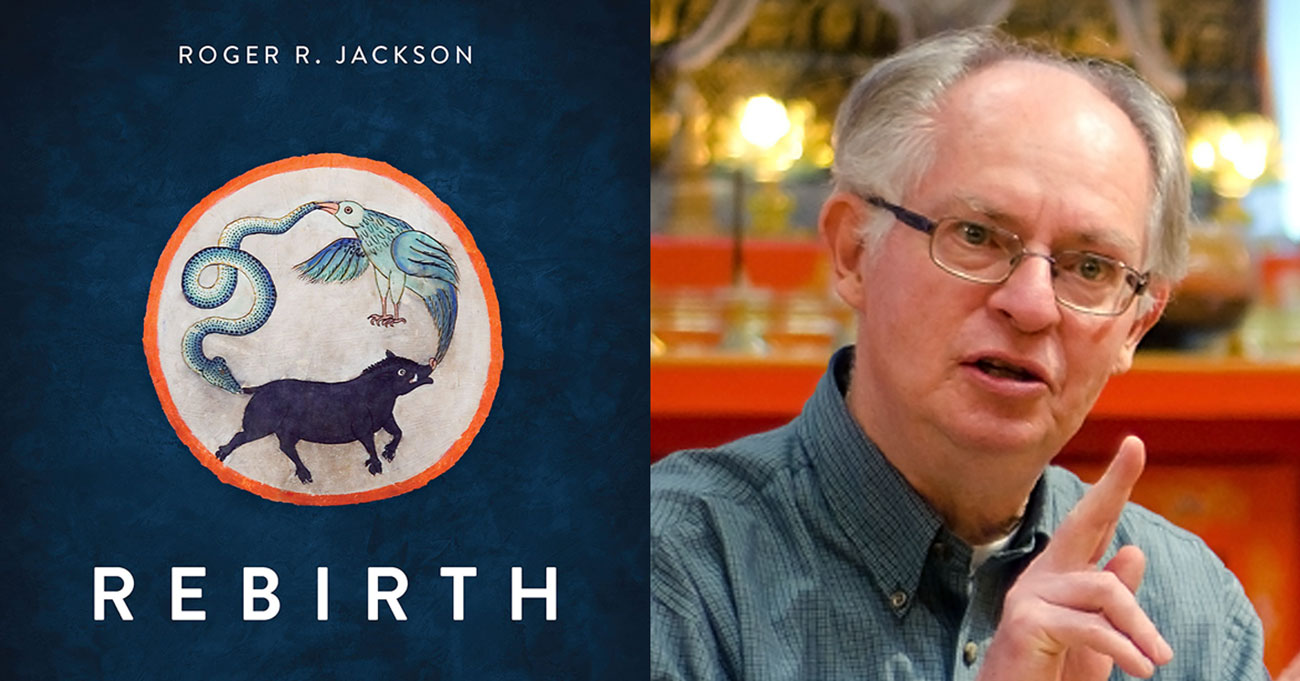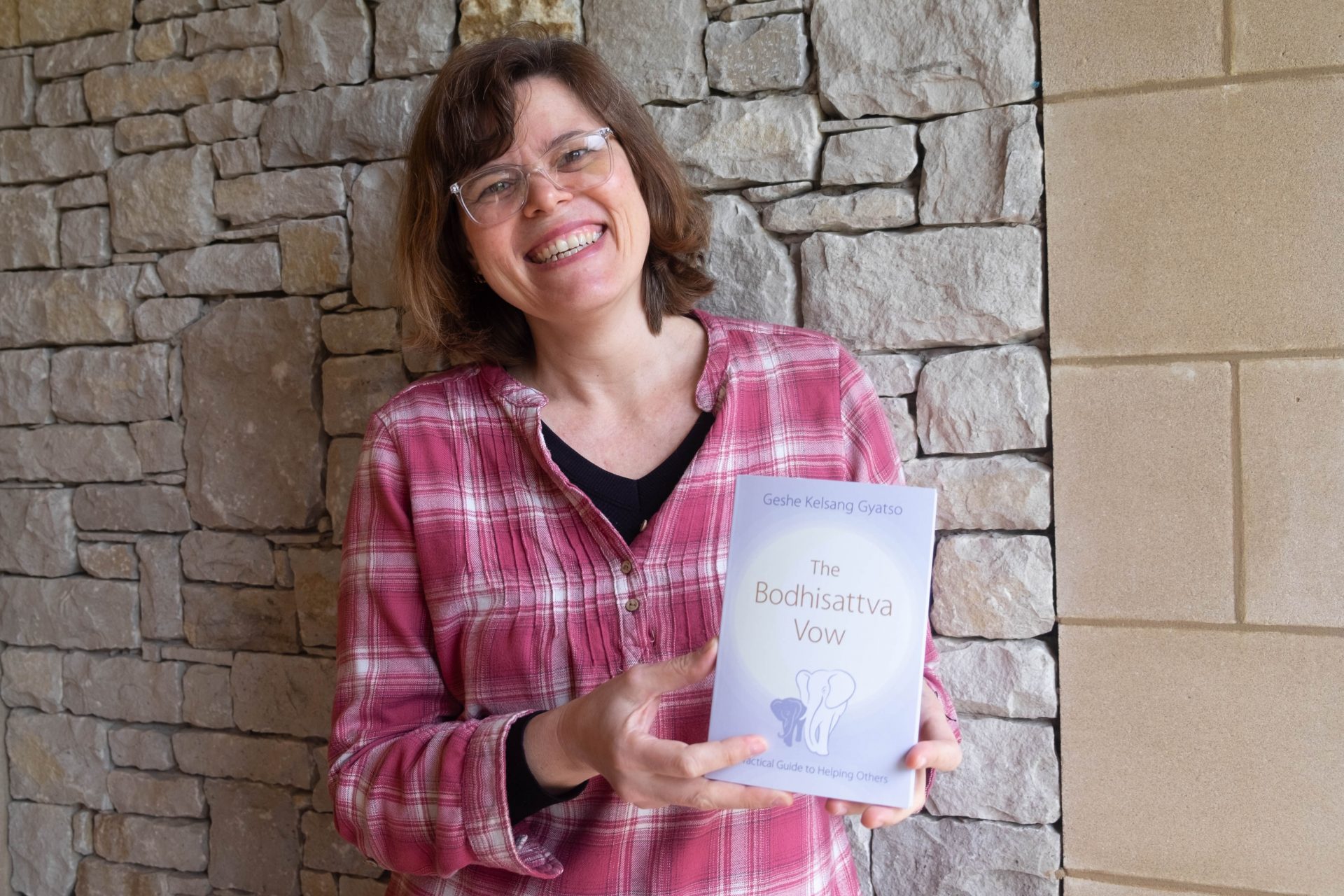A Case for ‘As-If Agnosticism’ as an Approach to Rebirth
In his new book, Roger Jackson details the prevailing perspectives on rebirth, including one for those who find the traditional rational, empirical, or faith-based arguments problematic but do not reject the idea outright. The post A Case for ‘As-If...

 Roger Jackson's new book Rebirth: A Guide to Mind, Karma, and Cosmos in the Buddhist World is out now with Shambhala Publications.
Roger Jackson's new book Rebirth: A Guide to Mind, Karma, and Cosmos in the Buddhist World is out now with Shambhala Publications.On Thursday, March 17, scholar, dharma teacher, and author Roger Jackson will lead a discussion with Tricycle on the doctrine of reincarnation, the topic of his new book, Rebirth: A Guide to Mind, Karma, and Cosmos in the Buddhist World. Register for the 4 p.m. ET event here.
Although most Buddhists in premodern Buddhist cultures accepted, and sometimes defended, the traditional Buddhist karmic eschatology, it is evident that since Asian Buddhists began to take account of modernity and Western Buddhists to take account of Asian traditions, those Buddhists that have bothered to talk about rebirth at all (and many have not), have typically done so by adopting one or the other of the four possible approaches to rebirth outlined below.
(1) Among literalists—who accept traditional descriptions of the karma-rebirth cosmology and arguments for it either unquestioningly or on the basis of their own analysis—the most common constituency is Asian Buddhists, whether in Asia or the West. These would include many traditionally trained Theravada monks and Tibetan lamas, with the latter category including such above-mentioned figures above as Sakya Trizin, Dudjom Rinpoche, Lama Zopa Rinpoche, and Kalu Rinpoche. Many of these teachers’ Western disciples have adopted a literalist idea of rebirth, as well, though they do not often write about their views, and what they do write is sometimes difficult to find outside of small Buddhist tracts and magazines.
(2) Neo-traditionalists—who seek to justify traditional cosmology and metaphysics in more “up-to-date” terms—comprise a large and diverse group. Among them, we might count Robert Thurman, who has argued for the truth and importance of the classical notion of rebirth but reframed it in evolutionary terms; B. Alan Wallace, who has argued on the basis of quantum physics that the mind is a more prominent factor in the cosmos than materialist science will allow, and, in the spirit of William James, that first-person experience is more reliable as a source of knowledge than philosophers will admit; Martin Willson, who finds rational arguments for rebirth unpersuasive but regards several types of empirical or experiential evidence as very promising; and the Fourteenth Dalai Lama, who accepts many of the premises and conclusions of Dharmakirti’s arguments, but limits their true applicability to the very subtlest level of the operations of mind and body, conceding that ordinary consciousness may indeed be impossible without neural activity.
(3) Modernists, who are uncertain about the literal truth of the traditional cosmology and metaphysics and generally unpersuaded by arguments for it, seek in various ways to maintain the language and imagery of karma, rebirth, and the realms of samsara—but recast in symbolic, psychological, or existential terms that are more amenable to modern sensibilities. Stephen Batchelor, with his “existential” interpretation of Buddhism, is the most prominent Western exponent of such an approach, but there are many others, as well. Alan Watts, for example, understood claims about past and future lives as a way of describing the multiple social roles we adopt in our present life. Trungpa Rinpoche seems (at times, at least) to have favored a largely psychological explanation of the six realms of rebirth and traditional ideas about death. David Loy recasts notions of rebirth within a new cosmological myth that effectively removes them from the traditional individual-survival framework. Richard Hayes regards rebirth as, at best, a useful fiction.
(4) Like those in the other groups, secularists vary in their motives and arguments, but are in accord that rebirth just doesn’t matter very much. Even if it was taught by the Buddha and his followers over the past two millennia, it is actually superfluous to the real meaning of the dharma, today as in pre-BCE. India: as a way to understand reality and live wisely, compassionately, and meaningfully within our present lives and in the common world we share. Thus, writers like Owen Flanagan, Robert Wright, and Jay Garfield deliberately put rebirth in abeyance when attempting to engage Buddhism with modern philosophy or psychology. Engaged Buddhists either reject the idea outright, as B. R. Ambedkar did, or largely ignore it, like Thich Nhat Hanh and many others. And, for the many modern people who do not identify as Buddhist but wish to draw on Buddhist insights and meditation techniques for specific purposes in their daily lives, rebirth is irrelevant at best, a distraction at worst, and in any case hardly worth worrying about.
These categories must be taken with many grains of salt: the lines between one and the other are not always sharp, such that, for instance, the difference between literalism and neo-traditionalism is not always clear, nor that between modernism and secularism. By the same token, many of the thinkers discussed here are too complex to assign solely to one category. Thus, in various contexts, the Fourteenth Dalai Lama may be read as a literalist, a neo-traditionalist, or a modernist—and he even has propounded a secular ethics that might align him with the fourth camp. Batchelor and Hayes may be classified as modernists but show strong secularist tendencies; indeed Batchelor, for his part, has most recently described his as a secular Buddhism, even though he presents Buddhist doctrines, including rebirth, symbolically and existentially, as a modernist would. And a figure like Thich Nhat Hanh, who largely eschews discussion of rebirth, hence appears “secularist,” clearly has both traditional and modern elements at work in his public ministry—and perhaps in his private convictions as well.
Literalism as Radical Cultural Critique
It might be argued that the very effort to think about Buddhism vis à vis modernity that generates these four categories is itself open to criticism. Most of the thinkers we have surveyed attempt in one way or another to align traditional Buddhist cosmology and metaphysics with modern Western ideas and practices, whether simply to make it comprehensible, to defend it, to reject it, or to reinterpret it along less traditionally “religious” lines. One might suggest, though, that such efforts stem from a failure to recognize that traditional Buddhism is in fact almost entirely incommensurable with modern science, psychology, and aesthetics. This is the stance taken by Donald Lopez in his analysis of “the Scientific Buddha”—the Buddha imagined by moderns as perfectly consonant in his life and teachings with the scientific perspective and procedures developed in the past several centuries in the West.
Lopez finds that such a Buddha never existed, and to posit him is to do serious violence to the way Buddhists have traditionally understood and lived in the world. According to Lopez, the Buddha and the tradition he founded are in most ways incompatible with modern, Western ideas and values, and must be acknowledged as such. Indeed, says Lopez, The Old Buddha, not the Scientific Buddha, presented a radical challenge to the way we see the world, both the world that was seen two millennia ago and the world that is seen today. What he taught is not different, it is not an alternative, it is the opposite. That the path we think will lead us to happiness instead leads to sorrow. That what we believe is true is instead false. That what we imagine to be real is unreal. A certain value lies in remembering that challenge from time to time.
Lopez says, in effect: don’t try to align Buddhism with science, psychology, or contemporary philosophy, don’t try to justify it, don’t try to reimagine it; rather, understand it as a radical critique of modernity and its complacencies. Perhaps, then, this is a fifth approach: literalism as radical cultural critique.
Lopez’s approach is a demanding one, for it forces modern Buddhists to hold in mind opposing ways of understanding the world, an exercise in “negative capability” only sustainable by a few.
The vast majority, I expect, will opt for one of the four approaches to rebirth outlined above, or some combination of them. Each of them, I believe, has a role to play in the ongoing colloquy among Buddhists as to how the tradition ought to be imagined and enacted in the modern world: literalists remind us of the classical Buddhist outlook, so different from our own; neo-traditionalists provide ways to argue for the traditional cosmology and metaphysics, or something akin to it; modernists either suspend or reject the classical paradigm, but find new, nonmetaphysical ways of making it meaningful; while secularists raise vital questions about just how much of tradition can be jettisoned in the process of finding a place for Buddhism in our disenchanted world.
Buddhist Agnosticism
My own view—certainly debatable—is that one or another form of modernism best points the way forward. I am particularly drawn to the various forms of “Buddhist agnosticism” that have been articulated in recent decades. The term was coined by Stephen Batchelor, but may appropriately be applied to any thinker who finds traditional rational, empirical, or faith-based arguments in favor of rebirth problematic but does not reject the idea outright, admitting that—with our present limitations—we simply do not know whether past and future lives are real. One interesting agnostic argument comes from an unexpected source, the late Tibetan lama Lati Rimpoche, who in a 1986 conversation with Buddhist scholar Richard Hayes suggested that Westerners uncertain about karma and rebirth (which Rimpoche concedes are “beyond absolute proof”) should remain open to the possibility that the traditional cosmology and metaphysics are true, and in any case behave as if they were true by living ethically and compassionately. In that way, they will generate happiness for themselves and others in this life, and if there are future lives, they will be happy ones; conversely, if they behave negatively, they will bring misery to themselves and others in this life, and face a sorrowful rebirth, if rebirths there are. As Hayes rightly notes, this argument (which appears in Indian Buddhist arguments as well) is akin to Pascal’s famous “wager” regarding the existence of God and the reality of final judgment. Leaving aside the question whether so tentative an acceptance of religious claims might itself be problematic in the eyes of God or amidst the subtleties of karma, we may agree with Hayes that Rimpoche seems to place these doctrines in a mythical space, as opposed to a historical or scientific framework. Access to this mythical space can be gained, not by logical proof or through a methodical empirical investigation of the sensible world, but by exercising one’s imagination and then having the courage of one’s imaginings.
For Hayes, reading traditional cosmology and metaphysics as myth—as “fictional”—allows modern people to imagine ways of living quite different from their own, not unlike a good novel; to the degree that a novel or other work of art may widen our perspective and ennoble our lives, to the same degree engaging with the traditional Buddhist imaginary allows modern Buddhists to enter more meaningfully into the streams of Buddhist life and provide meaning within their own.
Along similar lines, Batchelor opts for a “middle way” agnosticism in which one “does not have either to assert [rebirth] dogmatically or deny it; one neither has to adopt the literal versions presented by tradition nor fall into the other extreme of believing that death is the final annihilation.” This, he asserts, does not mire us in indecision. Rather, it allows us, as in Zen, to confront with ruthless honesty “the Great Matter of Life and Death,” and “is a powerful catalyst for action, since in shifting concern away from a hypothetical future life, to the dilemmas of the present, it demands…a compassion-centered ethic” that will bring joy to our lives and the lives of others. In his writings, Batchelor seems ambivalent about entertaining traditional cosmology and metaphysics even at the symbolic level; he often implies that we simply ought to get beyond these outmoded conceptions. Recall, however, that at the conclusion of a debate with Thurman hosted by Tricycle in 1997, he says that if he were to utilize the traditional Buddhist vision, “I would try to behave as if there were infinite lifetimes in which I would be committed to saving beings.”
As-If Agnosticism
I myself would argue without ambivalence for what I call “As-If Agnosticism.” My stance is agnostic because, like Hayes and Batchelor (and many others), I do not find traditional descriptions of karma and rebirth literally credible, nor am I fully persuaded by arguments in their favor, whether rational, empirical, or faith-based; on the other hand, I cannot rule out the possibility that such descriptions (or something akin to them) may in fact be true. The universe, after all, is surpassingly strange. In the spirit of Wallace Stevens’s famous statement that “we believe without belief, beyond belief,” I propose that we live as if such descriptions were true.
I am not suggesting we simply take up wishful thinking: if only there were past and future lives, if only karma works the ways tradition says it does, if only glorious and perfect buddhahood awaited us all at the end of the rainbow. Maybe they do, maybe they don’t. But as Buddhists have argued for millennia, Western humanists have claimed for centuries, and scientists have recently begun to recognize, the world is actually built far more on our ideas, aspirations, and speculations—the As-If—than we suppose, and the solid foundations we presume to lie beneath us—the “As-Is”—are much more difficult to find than we assume. It’s not, therefore, that by living as if certain doctrines were true we really are in flight from some bedrock, objective reality, because that reality—though it certainly imposes limitations on us, most notably at the time of death—turns out to be far more a matter of convention and far less “just the way things are” than we had thought. Freed from the illusion of perfect objectivity, therefore, why not think and live as if Buddhism were true? In doing so, we empower ourselves to enter, as fully as is possible in a skeptical age, into the ongoing, ever-changing life of the dharma, adopting Buddhist ideals, telling Buddhist stories, articulating Buddhist doctrines, performing Buddhist rituals, and embodying Buddhist ethics in ways that make meaning for ourselves, provide a measure of comfort to others, and perhaps contribute in some small way to the betterment of the imperfect and imperiled world in which we all live.
Let the final word belong not to me, however, but to the Buddha, who in the Rohitassa Sutta (Discourse about Rohitassa) recounts a previous life as a seer named Rohatissa, “possessing magical potency, able to travel through the sky…[with] speed like that of a light arrow easily shot by a firm-bowed archer.” Conceiving the wish to find the ends of the earth, he traveled for a hundred years as fast as the wind, yet “died along the way without having reached the end of the world.” There is no “end” to the geographic world, explains the Buddha, but that is not, in any case, the end-of-the-world we should be seeking. Rather, we must seek the place “where one is not born, does not grow old and die, does not pass away and get reborn.” And where is the end of the world in this deeper sense—nirvaṇa—to be found? “It is,” he says, “in this fathom-long body endowed with perception and mind that I proclaim (1) the world, (2) the origin of the world, (3) the cessation of the world, and (4) the way leading to the cessation of the world.” As a result,
“…the wise one, the world-knower, who has reached the world’s end and lived the spiritual life, having known the world’s end, at peace, does not desire this world or another.”
From Rebirth: A Guide to Mind, Karma, and Cosmos in the Buddhist World by Roger R. Jackson © 2022 by Roger R. Jackson. Reprinted in arrangement with Shambhala Publications, Inc. Boulder, CO. www.shambhala.com
♦
Watch Roger Jackson in conversation with Jay Garfield on the topic of rebirth from a Live@Tricycle event series called “Secularizing Buddhism.”

Get Daily Dharma in your email
Start your day with a fresh perspective

Explore timeless teachings through modern methods.
With Stephen Batchelor, Sharon Salzberg, Andrew Olendzki, and more
![]()
Thank you for subscribing to Tricycle! As a nonprofit, we depend on readers like you to keep Buddhist teachings and practices widely available.
This article is only for Subscribers!
Subscribe now to read this article and get immediate access to everything else.
Already a subscriber? Log in.

 BigThink
BigThink 
































